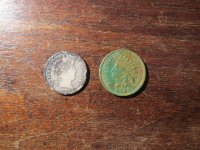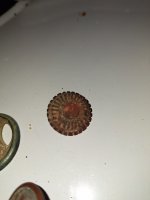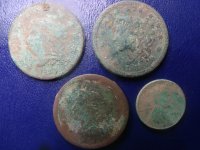how would you preserve a cannon ball that has been in the ocean for about 200 years? Heavy encrustations on half, clean metal on half. It's about 5 inches in diameter.
You are using an out of date browser. It may not display this or other websites correctly.
You should upgrade or use an alternative browser.
You should upgrade or use an alternative browser.
Cannonball preservation questions
- Thread starter bell47
- Start date
woody50
Bronze Member
- Jun 21, 2007
- 1,879
- 203
- Detector(s) used
- XP Deus
- Primary Interest:
- All Treasure Hunting
bell47 said:how would you preserve a cannon ball that has been in the ocean for about 200 years? Heavy encrustations on half, clean metal on half. It's about 5 inches in diameter.
I think iron and copper are two of the hardest materials to stabilize, and perserve.
Have you looked here: http://nautarch.tamu.edu/class/anth605/File0.htm
I don't profess that this method works, it does for me but if for instance if water has creeped into the center of the ball (unlikely?) heating it with my method could destroy it because of steam. So be careful..... and think about the risk to yourself and the object. Although this is the method I use, I would like to know what the pro's do with such iron items. I have one cannon ball about that size, one larger, and a few smaller ones. Found deep in the ground here in Holland where the ground is always wet and soggy (fresh water) but full of salts and minerals. I have dated them to the 17th/16th century, using other finds such as coins and objects in the same soil layer to date them. I have used this method on my balls (cannon of course) and they are now stable, not bleeding or flaking.
Remember also that if some of the part of the iron object are loose, rusted loose or fragile, heating it will normally remove those parts. But doing nothing will also result on losing those parts after some time.
I begin by cleaning them as good as I can, most of the time however there remains much gook on them that is hard to get off. Then depending upon their condition I have used my iron cleaning method using electrolysis with granular caustic soda as the electrolytes (conductor) to get rid of the gook and crusts. Its not so easy with big items and takes some time. But the crusts should come loose in a short time.
After that I soaking the object in distilled water for a period, changing the water every once in a while. The minerals and salts get 'sucked' out of the object by the distilled water, and in some time the water itself gets saturated with these salts and minerals. When the salts and minerals in the water equal the salts and minerals in the object the sucking will stop. I don't have the apparatus to measure what minerals are coming out of the object, to see how much longer I must soak it, so its a bit of guesswork to know when to change the water and when to stop. You must change the water, and continue until the minerals and salts do not appear in the water, or at a much lower amount. Problem is to know when the water is saturated, and for that you must measure the water with an apparatus which I don't have. So this step is guess work for me...
Then comes the drying out or heat treatment. I gradually heat the object, starting very low, raising the temperature higher and higher until I reach my high end of about 600 degrees centigrade (after hours or days depending on the thickness of the object). When I reach this temperature I continue for some time, hours or days. Don't know how to judge this so its mostly guess work for me. The larger and more solid a object is the longer I keep it in the oven. Sometimes I repeat this step after seeing the object after its cooled down.
Then I add an preservative, there are many things out there for the treatment of iron. I use this or that depending upon the object and how I want it too look, you know irony, steely or just like normal iron.
Like I said I have used this method on cannon balls (small ones) and many other iron objects, such as many roman artifacts such as knifes, locks, keys, horseshoes, hammers, etc. After treatment I put the objects in one of my display cases and wait. If nothing happens then I did it OK, but sometimes I have to repeat the action. Small thin items don't need such drastic methods, so I use this mostly for fairly thick iron items.
IF you DO nothing with an iron object that has been in water for a long period, only clean and dry it, it will begin to flake off after a time. And flake and flake until there is nothing left. Think about that.
Info also at (http://forum.treasurenet.com/index.php/topic,186239.msg1367019.html#msg1367019)
If you do use this method please let me know your results, or have a found a better method.
Users who are viewing this thread
Total: 2 (members: 0, guests: 2)





